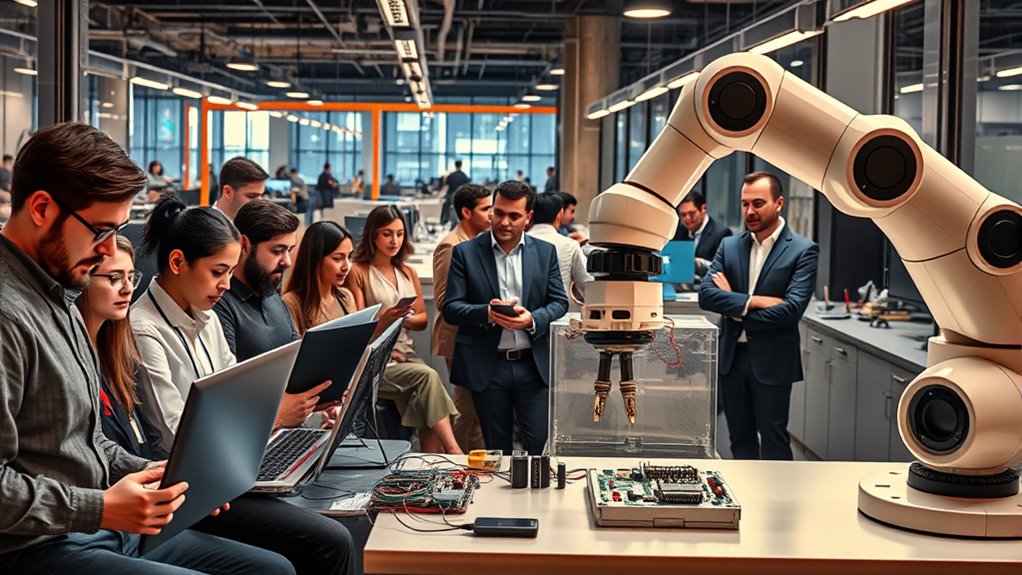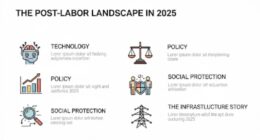AI is expected to create around 97 million new jobs globally by 2025, especially in sectors like software, creative arts, and security. However, it could displace up to 9% of current roles, mainly in manufacturing, writing, and customer service. While many jobs will change or shift, new opportunities are emerging, and economies are adapting. To understand how to navigate this evolving landscape and stay competitive, there’s more to explore.
Key Takeaways
- AI is expected to create approximately 97 million new jobs globally by 2025, outweighing the 14% of jobs displaced.
- Job displacement mainly affects sectors like writing, photography, and customer service, but new roles in AI, software, and creative fields are emerging.
- The overall economic impact of AI could boost GDP by 26%, with significant efficiency gains and new industry growth offsetting job losses.
- Workforce adaptation through reskilling and continuous learning is crucial, with 80% of employers planning to retrain employees by 2030.
- International policies and responsible AI frameworks aim to balance innovation with job protection, promoting sustainable and inclusive growth.
The Growing Promise of Job Creation Through AI

AI is opening up exciting opportunities for job creation, even as it transforms existing industries. You’ll see new roles emerging that demand different skills, prompting companies to invest in training programs. By 2025, studies predict around 97 million new jobs could be created globally, especially in sectors like manufacturing, software development, and creative fields. In manufacturing, AI enhances processes, speeds up product design, and streamlines logistics. Creative industries, such as photography and marketing, are experiencing a surge in AI-driven roles—photography jobs increased by 51%. Major metropolitan areas like California, Texas, and New York are leading regional hiring trends. Overall, AI’s growth could substantially boost job opportunities, encouraging workers to adapt and develop new skill sets for these evolving roles. Global employment figures also suggest that AI could help bridge skills gaps by making technical training more accessible to diverse populations, fostering inclusive workforce development. Additionally, the integration of AI into various sectors underscores the importance of labor market adaptability, which can be amplified through targeted training initiatives to ensure sustainable employment growth. Furthermore, as AI tools become more prevalent, they can facilitate upskilling efforts, enabling workers to transition into emerging roles more seamlessly. This evolving landscape highlights the significance of continuous education to stay competitive in the changing job market.
Analyzing the Displacement Risks in Various Sectors

As automation advances, certain sectors face higher risks of job displacement, especially where tasks are repetitive or easily replicated by algorithms. Jobs in writing, photography, and software development are vulnerable because AI can automate routine tasks, reducing the need for human input. By 2025, around 14% of workers have already been displaced by AI, including two million in manufacturing who could be replaced by robots and systems. Globally, up to 300 million jobs—about 9.1%—may be affected, though impacts vary across regions and industries. Creative fields, customer service, data entry, and accounting are particularly at risk. Automation has the potential to impact 60% of occupations with automable tasks, highlighting the substantial scope of AI-driven displacement. As the shift accelerates, labor market dynamics will likely change considerably, requiring adaptation and new skills for affected workers. Additionally, sectors like indoor gardening may see the emergence of new roles focused on plant care and maintenance, driven by technological innovations in smart gardening tools. The ongoing evolution of job roles underscores the importance of continuous learning and reskilling. Moreover, the rapid pace of technological change underscores the need for policies that support worker transition programs to mitigate displacement effects. CEOs expect significant job cuts, with one in four predicting a 5% or more reduction in workforce size in 2024.
The Shifting Skill Set and the Need for Workforce Adaptation

To stay competitive in today’s evolving job market, you need to prioritize continuous learning and develop digital literacy skills. As AI reshapes roles and creates new opportunities, bridging the skills gap becomes essential for workforce adaptation. Embracing these changes now will better prepare you for the jobs of tomorrow. AI’s long-term potential to automate cognitive functions underscores the importance of developing versatile skills that complement AI capabilities. Developing a strong foundation in adaptive learning technologies can help you stay ahead as workplaces continue to integrate AI-driven tools. Additionally, understanding specific tools like the Vetted Flat Iron Bike illustrates how specialized knowledge and adaptability are crucial in both tech and non-tech sectors. Recognizing relationship dynamics and developing soft skills such as empathy and active listening can also serve as a competitive advantage in human-centric roles. Building digital literacy skills is fundamental to navigating future job markets effectively.
Emphasizing Continuous Learning
The rapid integration of AI into workplaces is transforming the skills required for success, making continuous learning essential. You need to stay updated on AI literacy, which will be the most in-demand skill by 2025, and develop adaptability to keep pace with changing job requirements. Understanding process automation helps you integrate AI into workflows effectively, while innovative thinking becomes critical as routine tasks are automated. Conflict mitigation skills are also increasingly valuable as workplaces become more complex. To remain competitive, you must engage in ongoing training and leverage AI literacy programs. Companies investing in continuous learning platforms will support your growth, ensuring you develop the skills needed to work alongside AI and seize new job opportunities. Adaptability through lifelong learning is your best defense in this evolving job landscape. Additionally, 80% of employees see benefits from AI releasing knowledge workers, highlighting the importance of ongoing skill development to fully leverage AI’s potential. Staying informed about the Basics of Soaring and Gliding can also teach you the value of continuous skill development and adaptation in specialized fields.
Developing Digital Literacy Skills
Continuous learning prepares you to keep pace with evolving skills, but developing strong digital literacy is now more important than ever. Digital literacy means confidently, creatively, and critically using technology to handle daily tasks, learn, and work effectively. Key skills include evaluating information, understanding digital communication, cybersecurity awareness, and familiarity with AI and automation tools. As industries transform digitally, proficiency in these areas becomes essential to stay competitive and adaptable. Your ability to find, create, and share information digitally underpins success in modern workplaces. It also helps reduce operational bottlenecks and boosts organizational security. Developing these skills requires ongoing effort, targeted training, and a willingness to embrace new technologies—making digital literacy a crucial foundation for thriving amid rapid technological change. Digital literacy has become a vital component of workforce readiness in the evolving digital economy.
Bridging the Skills Gap
As AI transforms industries, workers must adapt to a rapidly evolving skills landscape. Core skills are expected to change about 40% by 2025, and specialized AI roles face up to 15% vacancy rates. To close this gap, 80% of employers are planning workforce training by 2030. Despite displacement, AI is projected to create a net 78 million jobs globally by 2030, with increasing demand for hybrid roles that combine technical and domain expertise. Employers recognize reskilling as essential, with 85% prioritizing it. Companies are developing training programs and promoting AI literacy to guarantee workers stay relevant. However, the skills chasm remains a challenge, and organizations must adopt ongoing adaptation strategies to navigate AI-driven changes in the workforce.
Economic Impacts: Growth Versus Cost Savings

As AI drives economic growth through new job creation and industry expansion, it also offers significant cost savings via automation. You’ll need to contemplate how these opposing forces influence market dynamics, with growth fueling opportunities and cost-cutting prompting layoffs. Balancing these impacts is key to understanding AI’s true economic effect on your industry and workforce. Substantial job growth projected, along with the automation of routine tasks, highlights the complex interplay between employment opportunities and potential displacement. Additionally, the integration of AI in Business accelerates data processing and enables real-time insights, further shaping the economic landscape.
Economic Growth Opportunities
Have you ever wondered how artificial intelligence can drive economic growth beyond just cutting costs? AI’s market size is projected to reach $4.8 trillion by 2033, up from $189 billion in 2023, fueling global expansion. With a growth rate of 26% in 2025, AI is transforming industries and boosting productivity, potentially adding $4.4 trillion in corporate efficiency gains. By the end of the decade, AI could increase GDP by 26%, creating new opportunities for businesses and workers alike. The demand for AI-related roles will grow, needing around 97 million new jobs by 2025. Additionally, AI-driven innovation attracts investments, with global chip revenues expected to surpass $80 billion by 2027. This rapid growth signals a significant boost to the economy, opening new avenues for prosperity. As AI integrates into various sectors, technical skills will become increasingly valuable for the workforce. Furthermore, the integration of preppy dog names into marketing strategies illustrates how cultural trends influence economic sectors, highlighting the interconnectedness of market dynamics and consumer preferences. Understanding the industry-specific impacts of AI can help businesses adapt and thrive in this evolving landscape. Moreover, advancements in Breakthrough Technologies in 2024 such as quantum computing are expected to further amplify AI capabilities, leading to even more substantial economic benefits.
Cost Reduction Benefits
Curious about how AI can substantially cut operational costs? You’ll find that AI automates repetitive, labor-intensive tasks, drastically reducing expenses. Predictive analytics optimize processes, saving money without sacrificing quality or efficiency. For example, JPMorgan Chase’s COIN automates contract analysis, replacing thousands of hours of manual work and lowering legal costs. AI-driven automation spans functions like coding, risk analysis, quality control, and customer service, delivering broad cost savings. Advances in models like Grok 3 further enhance insights and automate complex decisions, enabling smarter cost strategies. These efficiencies not only cut expenses but also free resources for innovation. As a result, your business can operate leaner, competitive, and more adaptable, all while boosting profitability. Ultimately, AI’s cost reduction benefits reshape how organizations manage expenses and optimize their bottom line.
Market Shift Dynamics
AI is fundamentally reshaping the job market by driving both economic growth and workforce transformation. You’ll see new jobs emerging, with around 97 million expected by 2025, often in creative and security sectors, and a 17.9% increase in software development roles through 2033. AI is also expanding into manufacturing, with new roles in robotics and process optimization, and in creative fields like photography, where jobs have grown 51%. However, job displacement remains a concern—up to 9.1% of jobs worldwide could vanish, especially in manufacturing, where two million roles may be replaced by automation. As AI reshapes industries, you’ll need new skills, and some regions may face labor shifts, while others experience growth. AI job postings peaked at over 22,000 in October 2024, highlighting the ongoing demand for AI talent. Balancing these dynamics is key to understanding AI’s true economic impact.
Future Trends: Emerging Roles and Continuous Learning

As technology advances, new roles are emerging that require you to adapt and expand your skill sets. You’ll find roles like AI Ethics Officers, ensuring AI operates fairly, and Human-AI Collaboration Specialists, optimizing workflows. AI Trainers will teach systems to understand nuance and human values, while Data Scientists and ML Engineers build and maintain these systems. Industry-specific experts, like Medical AI Trainers, focus on applying AI in healthcare, and AI-Radiology Integration Specialists ensure seamless integration. To stay relevant, continuous learning is key—upskilling, AI literacy, and combining domain expertise with technical skills become essential. Adaptive learning platforms personalize your growth, and collaborative learning with AI helps improve efficiency. Embracing these emerging roles and ongoing education prepares you for a future where AI reshapes the job landscape.
Addressing Talent Gaps and Promoting Social Mobility

Despite the rapid growth of AI-related job opportunities, a significant talent gap persists, making it hard for organizations to find skilled professionals. The demand for AI talent is high, yet up to 50% of these roles remain unfilled. You’ll notice that:
Despite booming AI jobs, half remain unfilled due to skills shortages and uneven access to training.
- 20% of companies lack employees skilled in AI tools, with 16% struggling to hire new talent.
- Many organizations lag in training workers, worsening shortages.
- Support for AI upskilling varies globally, often excluding marginalized groups.
- Programs combining technical AI skills with domain knowledge can boost social mobility.
Bridging this gap requires coordinated efforts in education, corporate training, and policy. Promoting wider access to AI education and fostering inclusive upskilling initiatives can help workers adapt and move upward in the evolving job landscape.
Navigating Global Cooperation for a Balanced AI Workforce

Global cooperation plays a pivotal role in shaping a balanced AI workforce worldwide. Countries are developing policies to regulate AI responsibly and ethically, ensuring that innovation benefits everyone. International collaboration helps set standards for AI adoption, preventing job displacement and promoting workforce stability. Education reforms and industry partnerships are key to closing skill gaps and creating seamless pathways from training to employment. By working together, nations can accelerate upskilling efforts and share best practices. Here’s a snapshot of current global efforts:
| Focus Area | Action Steps | Outcomes |
|---|---|---|
| AI Policies | Developing responsible frameworks | Ethical, balanced AI integration |
| Education & Training | Industry partnerships, upskilling programs | Better workforce preparedness |
| International Cooperation | Setting global standards | Reduced job displacement, fair growth |
Frequently Asked Questions
How Will AI Impact Job Quality and Worker Satisfaction Long-Term?
You’re likely to see AI improve job quality and satisfaction over the long term by automating repetitive tasks, freeing you for more strategic and creative work. As you develop new skills, your role may become more fulfilling, and efficiency gains could lead to better work-life balance. However, staying adaptable and embracing ongoing training will be key, as AI’s impact depends on how well you adjust to technological changes.
What Industries Are Most Resilient to Ai-Driven Automation?
You’ll find that healthcare, education, creative industries, and skilled trades are most resilient to AI-driven automation. These sectors rely heavily on human empathy, nuanced decision-making, and creativity that AI can’t replicate yet. In healthcare, patient interaction remains crucial. Education depends on personal mentorship, while arts and trades require intuition and adaptability. You’ll notice these industries experience steady growth, as their human-centric roles remain essential despite technological advancements.
How Can Policymakers Ensure Equitable AI Job Opportunities Globally?
You might think policymakers have it all figured out, but ensuring fair AI job opportunities worldwide is no simple task. They need to invest in equitable education, support upskilling, and create inclusive policies that reach all socioeconomic groups. Encouraging international cooperation and establishing safety nets will help, too. After all, if AI’s going to reshape jobs, it’s only fair everyone gets a chance to benefit from its promise.
Will AI Replace Human Creativity and Emotional Intelligence in Jobs?
You might worry that AI will replace human creativity and emotional intelligence in jobs, but that’s unlikely. AI can generate content and analyze patterns, boosting productivity, but it lacks genuine emotion and intuition. Instead of replacing you, AI will be a tool to enhance your creativity and decision-making. Your emotional insight and human touch remain irreplaceable, making collaboration with AI a powerful way to evolve work and innovate.
What Strategies Can Organizations Implement to Reskill Displaced Workers Effectively?
Did you know that 87% of HR professionals believe reskilling is essential for adapting to AI? To reskill displaced workers effectively, you should implement industry-specific training, especially in sectors less prone to automation like healthcare. Use AI-driven personalized learning and online platforms for accessible, cost-effective education. Foster continuous learning through partnerships, mentorships, and community outreach, ensuring workers gain relevant skills and find new opportunities in the evolving job landscape.
Conclusion
As you stand at this crossroads, remember that AI is like a double-edged sword—it can cut deep into jobs but also carve out new opportunities. Your adaptability is the key to turning this technological tide into a wave of growth. Embrace continuous learning and stay flexible, and you’ll ride the crest of innovation rather than be swept under. With the right skills and mindset, you can shape a future where AI is your ally, not your adversary.









